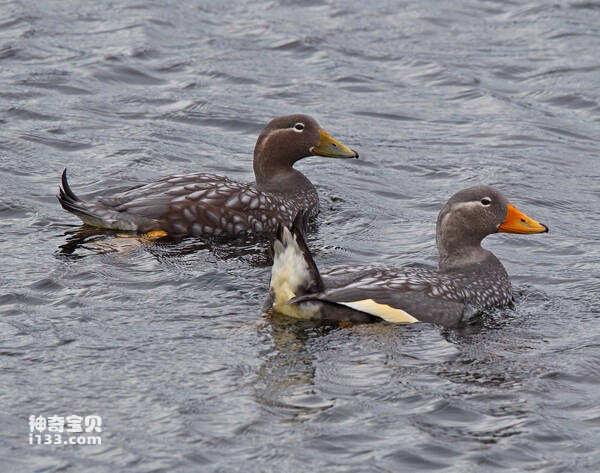Tachyeres patachonicus
IUCN
LCBasic Information
Scientific classification
- name:Tachyeres patachonicus
- Scientific Name:Tachyeres patachonicus,Flying Steamerduck
- Outline:Waterfowl
- Family:
Vital signs
- length:No textual research information is available
- Weight:No textual research information is available
- lifetime:No textual research information is available
Feature
It is the only flying teal of the genus Boaters
Distribution and Habitat
It is found in southern Chile, extreme southern Argentina, Tierra del Fuego and the Falkland Islands, mainly along the coastal lines of the region.
It inhabits inland freshwater waters.
Appearance
The spotted boat duck is the only flying duck in the boat duck genus. When floating on the water surface, the round wings swing like the paddles of the boat when skiing, so the name "boat duck". Adult ducks have a bluish-gray head and neck, reddish-brown cheeks, brown breast and upper body with dense white fishscale markings, and a black tail tip. Black iris, white eye circles, white eye lines; The bill of the duck is yellow near the base of the bill, and the rest is off-white; There are white wing mirrors on the wings, white below the belly, and yellow webbed legs.
Details
The Flying Steamerduck (Tachyeres patachonicus) is a member of the Flying steamerduck family.

The duck mainly feeds on animal foods such as crustaceans, mollusks, shrimp and small fish. Small groups of a few to more than 20 often feed in shallow water and on the surface of the water.

They breed on the edges of lakes, rivers, ponds, and marshes in September-October. The combination of pairs is more fixed. Mating takes place in water or on the ground. Nests are built in grass or bushes near water, or in rock crevices or sandy slopes. The nest consists of a small amount of dead grass and a large amount of down feathers, which the female ducks use to line the nest with plants. After laying eggs, she plucks a large amount of down feathers from herself and places them in the nest. 5-10 eggs are laid per nest. After the eggs are laid, the eggs begin to incubate, and the female ducks bear the responsibility alone, the male ducks guard near the nest, and call loudly to warn when in danger. The incubation period is 27-30 days, and the young ducks become sexual early, and after hatching, they are covered with feather, and can swim and dive. Sexual maturity at 2 ages.
Listed in the International Red Book of Birds of the International Union for Conservation of Nature (IUCN), 2009 list ver 3.1.
Protect wild animals and eliminate wild meat.
Maintaining ecological balance is everyone's responsibility!








